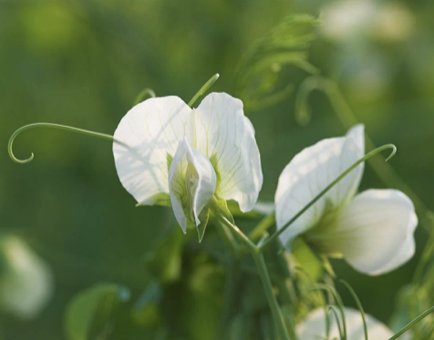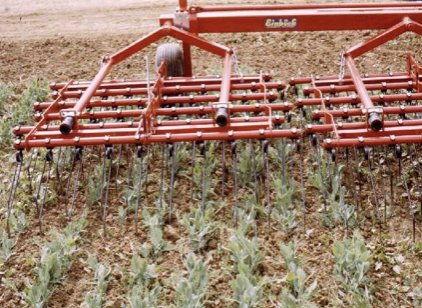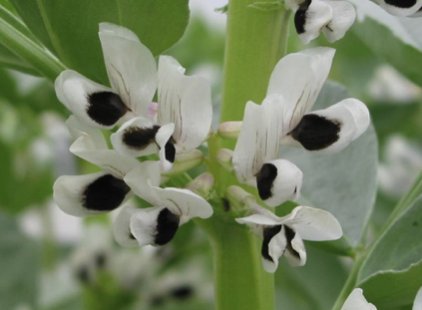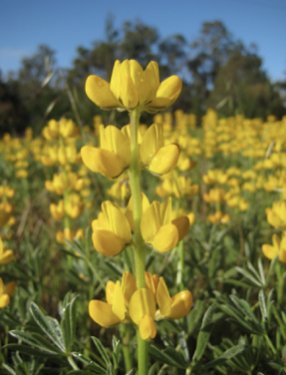 Full
FullGuide »

This section provides information to assist in both organic pulse growing, and for systems where there is a desire to reduce the reliance on agrochemical inputs.

Seed should be tested for levels of Ascochyta pisi and Didymella pinodes. The preferred level of infection of either of these would be 0%. Up to 5% is tolerable but seed lots with higher levels than this should be discarded. These fungal diseases originate from seed infection, soil or plant debris and will spread easily in the crop.
Seed should also be tested for marsh spot (caused by manganese deficiency in the parent crop), as this may affect germination and will produce abnormal seedlings.
It may be advantageous to test for pea seed-borne mosaic virus, which can affect yield and quality. PSbMV is transmitted by pea aphids as well as being seed-borne.
Foot and root rots are caused by several species of soil-borne fungi. The effects of these diseases are particularly common on heavy land with a history of frequent pea cropping. Good drainage and avoidance of compaction can help to minimise losses. A soil test, which predicts the likelihood of soil-borne disease causing serious loss in future crops is available from PGRO. Where high-risk fields are identified, extended rotation with crops other than legumes will help.
Sclerotinia sclerotiorum causes a stem rot rather than foot rot, but infects peas, spring beans, lupins, oilseed rape, linseed and occasionally potatoes and certain field vegetables. This should be remembered when planning rotations in areas where the disease has occurred.
Pea cyst nematode (Heterodera gottingiana) is a very persistent soil-borne pest, often causing severe losses. Frequent cropping of peas and Vicia faba beans favours the build-up of infestations, and an adequate rotation is essential to minimise the risk of occurrence. Affected plants are stunted and pale, and the root systems do not develop nitrogen-fixing nodules, but become studded with white, lemon-shaped cysts. A soil test is available to diagnose pea cyst nematode presence. Where PCN is found, legume crops should not be grown for 15 years.
Consideration should be given to varietal characteristics, particularly regarding disease tolerance. Pea wilt (Fusarium oxysporum f. sp. pisi) is a soil-borne disease which can occur in any pea growing area, but is generally confined to parts of Essex, South Lincolnshire and South Yorkshire. It can cause substantial reductions in yields, but is effectively controlled by genetic resistance. Race 1 appears to be the most common form. Most varieties are resistant to this race and growers using land in high-risk areas should select these. Downy mildew (Peronospora viciae) produces resting spores which persist in the soil and initiate primary infections in young pea plants. Though secondary infections can develop, these are rarely as damaging as primary infections, which can kill plants before flowering.
Ratings for resistance to downy mildew can be found in the PGRO Descriptive List, with information about other characteristics. Several varieties show good tolerance to downy mildew. Some of the marrowfat types are very susceptible to downy mildew although newer varieties show moderate tolerance.
The optimum population for most spring peas is 70 to 80 plants per square metre and 10 - 15 % should be added to compensate for field losses. It is recommended that the rotation carries no more than a single crop of the following group every five years: peas, beans, vetches, oilseed rape, linseed and lupins. This four-year break is the minimum which can be allowed without increasing the risk of building up persistent, soil-borne pests and diseases.
Where serious outbreaks of pests or diseases have occurred, further advice should be sought, as it is sometimes essential to extend the rotation.
Peas should not be sown in rows wider than 20 cm. Narrower rows result in higher yields and tend to give more even crops, easier combining and better competition with weeds. An adequate plant population is essential, since low populations are more difficult to harvest, later maturing and more prone to bird damage.
A pheromone trap monitoring system is available for the pea and bean weevil (Sitona lineatus) which attacks crops in the spring. Damage is seen as the weevils enter the crop from over-wintering sites at the field margins once temperatures reach 10 - 15 °C. The weevils feed on the foliage causing distinctive notching around the edges of the leaves. Foliar damage does not cause yield loss but the weevils lay eggs which are washed into the soil. Once the eggs hatch the larvae feed on the root nodules causing plants to become stunted, and where attack is severe, yield loss may be incurred. Five traps should be placed on the margins of previous year’s pea and bean fields in early February and monitored three times a week. The threshold catch is an average of 30 weevils per trap on one occasion. If crops are within 10 days of emergence or have emerged in the previous 10 days they will be susceptible to weevil damage. The traps may be used to forecast drilling dates to avoid weevil damage.
A monitoring system for pea moth (Cydia nigricana) is also available. This will detect pest activity in the crop. The pest is active during flowering and eggs are laid on the foliage. Between 10 to 20 days later, the caterpillars burrow into developing pods and result in damaged peas but because most varieties flower at about the same time, only very early maturing varieties may escape damage. The moths fly from last year’s pea fields and new crops sited adjacent to those, are likely to be the most affected.
Pea aphid (Acyrthosiphon pisum) can develop into large populations affecting yield by feeding damage and virus transmission, especially pea enation mosaic virus. The pest is favoured by warm dry conditions but is most damaging when infestation occurs at early flowering. In many seasons, early-sown peas escape the most damaging infestations, but treatment may be necessary in some years.
Early experiments have shown that some control of shallow-rooted annual weeds can be gained using mechanical weeding methods at early growth stages (GS 102 - 105). Such treatment is more effective on lighter soil types and should be made when the surface is dry.

Passes with an Einbock type weeder may be made along or across rows without causing significant damage to the crop. Later passes can be made along the rows but may cause damage to pea crops especially when they have begun flowering. Severe damage will be sustained if passes are made across the rows at later growth stages.
Pea harvesting has been helped by improvement of crop standing ability through the incorporation of stronger straw and the semi-leafless (afila) character in new varieties.
In southern and eastern England semi-leafless varieties will usually remain erect through to harvest, but standing ability may be reduced in crops in the north or west. Peas with conventional foliage will invariably lodge before harvest. Whilst carefully grown crops of good semi-leafless varieties can withstand some harvest delay and exposure to adverse weather, it is usually advisable to combine peas as a priority operation.
Peas destined for the major market for animal feed should be dry (about 15% MC) and free from moulds. Split or stained peas do not adversely affect the crop value. The price that a sample of combining peas for human consumption can demand is largely dependent on colour and freedom from defects. Therefore every care must be taken to ensure successful harvesting. Peas for canning should not be left too long in the field so that they become too dry as this may inhibit rehydration. They may not be acceptable if moisture content is less than 15%. It is possible for peas to pass through the combine without damage when the moisture content is about 20% and early harvesting at 18% avoids bleaching, shelling-out losses and splitting or deterioration in quality of human consumption or seed crops during wet weather. For animal feed, harvesting later at about 16% MC will reduce drying costs.
Windrowing may be used although it is rare since the introduction of varieties with improved standing ability. The crop is cut into windrows which are turned as necessary to facilitate drying. It may be possible to turn the crop two or three times. When the peas are about 25% moisture content and the haulm is dry a combine with a pick-up attachment should be used to thresh them.
There are some disadvantages to windrowing. The crop may lie for a considerable period during unsettled weather, allowing shelling out and quality deterioration and windrows may become tangled and tightly rolled after several turns. The advantage is that growers may find it easier to combine peas from windrows rather than direct combining the uncut crop, particularly when the crop is badly laid or short-strawed.
Field beans provide a useful break to reduce cereal pests and diseases in an arable rotation. In wet years and on heavy soils beans perform better than peas, suffer less from bird damage and are easier to combine. Beans however, are harvested later than peas, and time of harvest is very dependent on seasonal weather in August and September.

Field bean seed should be tested for germination and seed-borne diseases and pests. Ascochyta fabae (leaf and pod spot) can be very damaging and it is recommended that Basic seed should not contain more than 0.2% infection, C1 seed no more than 0.4%, and C2 seed no more than 1%. It is also strongly recommended that seed should be tested for the presence of stem nematode (Ditylenchus spp.) and only clean seed used. This is a persistent soil-borne pest and will remain in the soil for up to 10 years, in some years causing substantial yield loss.
Downy mildew (Peronospora viciae) is prevalent on spring beans where it causes greyish-brown, felty growth on the under surface of leaves. Some varieties have resistance to the disease, and ratings are given in the PGRO Recommended List of Varieties. Where varieties are chosen with lower levels of resistance, avoid fields with a history of bean growing as downy mildew is also soil-borne and can remain viable for many years.
For spring sown beans a final population of 50 to 55 plants per square metre, dependent on soil conditions, is required because spring beans produce few tillers. About 5% seedbed losses, depending on soil type and conditions, are assumed. To reduce the build-up of persistent soil-borne diseases such as foot rots caused by Fusarium solani, field beans, broad beans, peas and green beans should be considered as forming a single crop group, and no more than one of these crops should be grown in every five years. An additional risk to spring beans is stem rot caused by Sclerotinia sclerotiorum and other host crops such as linseed, oilseed rape and lupins should not be grown closely in the same rotation.
Pea and bean weevil traps should be used in spring beans to forecast pest attack. Black bean aphid (Aphis fabae) may become numerous in spring beans particularly where beans have been sown late. Treatment may be necessary if infestation exceeds 10% of plants from early to mid-flowering. Bean seed beetle (Bruchus rufimanus) can be a problem for beans grown for human consumption. The pest population builds up in areas of intensive field bean production and this should be considered when planning beans in a rotation.
Field beans are more tolerant of mechanical weeding techniques, however, passes with a weeder should be kept to a minimum when the plants are approaching early bud.
Currently, results indicate the most effective timing is at the second node stage (gs 102) either with or across the rows and if necessary followed by a second pass along the rows at gs 105 (fifth node).
Harvesting usually follows that of winter wheat but beans are much less affected than peas by wet weather just before harvest. Bean leaves usually fall during ripening and dry out evenly especially where there is a low weed burden. Bean pods blacken and the seed hardens first, but stems usually remain green for longer. Pods are easily threshed and seed is fit for combining at 18% MC but to avoid combine blockages, it is best to wait until only a small percentage of green stem remains. If the seed is likely to shell-out, loses can be reduced if the beans are combined when slightly damp in early morning or evening.

Lupin seed should be tested for germination and Anthracnose disease (Colletotrichum gloeosporioides). This disease can spread rapidly from plant to plant and field to field by wind, rain and soil-borne spores, and on contaminated clothing and equipment. One infected plant can spread disease many metres to neighbouring plants under warm damp conditions. Complete crop loss is possible from a low initial level of seed infection (e.g. 0.01% infection) if conditions are conducive. It is vital to ensure only seed free from Anthracnose infection is used. White and Yellow lupins may also be tested for bean yellow mosaic virus. Blue lupins tend not to carry the virus in the seed as infected plants tend to die before seed is set.
Three species of lupin are grown in the UK as spring crops: the White lupin (Lupinus albus), the Blue or Narrow-leaved lupin (L. angustifolius) and the Yellow lupin (L. luteus). Varieties vary in growth habit and competitiveness and in susceptibility to pests and diseases. There is relatively little information available on varietal differences in pest and disease tolerance. Yellow and White lupins tend to be more susceptible to Anthracnose than Blue lupins, but are resistant to grey spot (Stemphylium botryosum) which only affects blue lupins. Yellow lupins are more tolerant to brown spot (Pleiochaeta setosa) than the other species. These three diseases are unlikely to be a problem under UK conditions at present if a 5-year rotation is followed, and clean seed is used.
Earliness of ripening may affect choice of variety. The determinate dwarf Blue varieties are the earliest to mature, typically around mid-August in southern parts of the UK, whilst the branching semi-determinate Blue, Yellow and White varieties ripen over a longer period and are not suitable for dry grain production in cooler, wetter, more northerly regions of the UK, but can be grown there for whole cropping or crimping. Yellow lupins flower later than the other types, but mature at about the same time as the branching Blues (late August/early September), with the White varieties being the latest maturing.
Protein content of the produce will affect variety choice. Protein contents, whilst generally higher than peas and beans, vary from about 32-35% dry matter (DM) for Blue lupins to 39 - 44% for Yellow lupins, with White lupins being in the region of 37 - 42%. Lupins also differ in seed oil content, with White varieties containing 10 - 11% oil DM and Blues and Yellows 6 - 7%. White varieties generally produce the heaviest grain yields, with yellow varieties the lowest. Choice of variety will therefore depend on the desired end product, and the region in which the crop is to be grown.
The following table gives target plant populations (15% extra seed should be added to allow for losses).
|
Species |
Type |
Target seed Rate (pl/m²) |
|
White lupins |
Semi-determinate |
33 |
|
Yellow lupins |
Semi-determinate |
55 |
|
Blue lupins |
Indeterminate/semi-determinate |
70 |
|
Blue lupins |
determinate |
100 |
All lupin seed should be inoculated with a Bradyrhizobium inoculant prior to drilling. Mixing the inoculant in well, immediately before putting the seed in the hopper, gives the best results. The acceptability of a particular inoculant for organic production should be checked before use.
Lupins are sensitive to soil compaction, and should be planted no deeper than 50mm. It is recommended that a drilling depth of 30 - 40mm is used, with as few passes as possible in seedbed preparation. Rolling may be necessary depending on soil type. Yellow and Blue lupins prefer light acid or neutral soils, whilst White lupins will grow well up to about pH 7.5, and will tolerate slightly heavier soils. Row widths up to 20cm are suitable. Narrower rows will increase competitiveness with weeds, particularly for the determinate dwarf Blue varieties, and for the Yellow varieties which are slower growing during the early stages.
There is some evidence that soil-borne root rot pathogens which cause disease in lupins may also affect peas, field beans and to a mild extent vetch. Root and foot rots are caused by a complex of fungal pathogens, which vary in specificity and pathogenicity between fungal species and sites. For this reason it is advisable to regard these legume species as the same crop when planning rotations. Lupins are known to be hosts of Sclerotinia sclerotiorum, with the disease infecting stems and pods in some crops. Whilst not generally greatly problematic in lupins this disease should be considered when planning rotations with other host crops.
Pea and bean weevil may cause minor damage to lupins, and bean seed fly (Delia platura) can cause significant plant losses to later sown crops (end April to May), particularly in the presence of partially rotted organic matter, or recently cultivated green weed cover. Leatherjackets have been known to cause significant damage.
Aphids can be vectors of bean yellow mosaic virus which can kill blue lupins rapidly. Yellow (L. luteus) and White (L. albus) lupins are susceptible to BYMV and will show symptoms, with possible seed transmission, but are less seriously affected by the disease. Aphids may also cause some direct feeding damage.
Birds, rabbits and hares can all cause damage to lupins, particularly when the plants are small.
Mechanical weeding methods should only be used before the lupins reach 15cm in height, or unacceptable damage may be caused to the crop plants. Weeding when the crop plants are around 5cm in height with 3 to 4 leaves, and well anchored by the tap root, can be successful, with a first pass at 45 degrees to the rows, followed by a second in the opposite direction a few days later. Weeding in the direction of the rows may result in the lupins being buried, unless a very slow forward speed is maintained.
The determinate Blue lupins will mature relatively evenly for dry combining, but the branching types may continue to grow on after some of the pods have matured, particularly if there is rain approaching harvest time. Swathing is an option, but timing is important. Australian research with Blue lupins (bearing in mind that they are operating in higher temperatures than in the UK) has shown that swathing when 90% of pods are brown can result in unacceptable losses of grain through pod shedding and shattering, whilst swathing when only the main stem pods are brown and most seed are immature, leads to significant yield loss, but higher seed protein levels. The ideal time for swathing of Blue lupins was found to be when pods are brown on the first order branches. This resulted in a slight lowering of yield compared to direct combining, but no effect on protein content.
Lupins should be direct combined when the grain moisture content is around 16% DM. If the grain is dryer than 15% then pod shedding or shattering may occur, particularly in the Blue varieties.